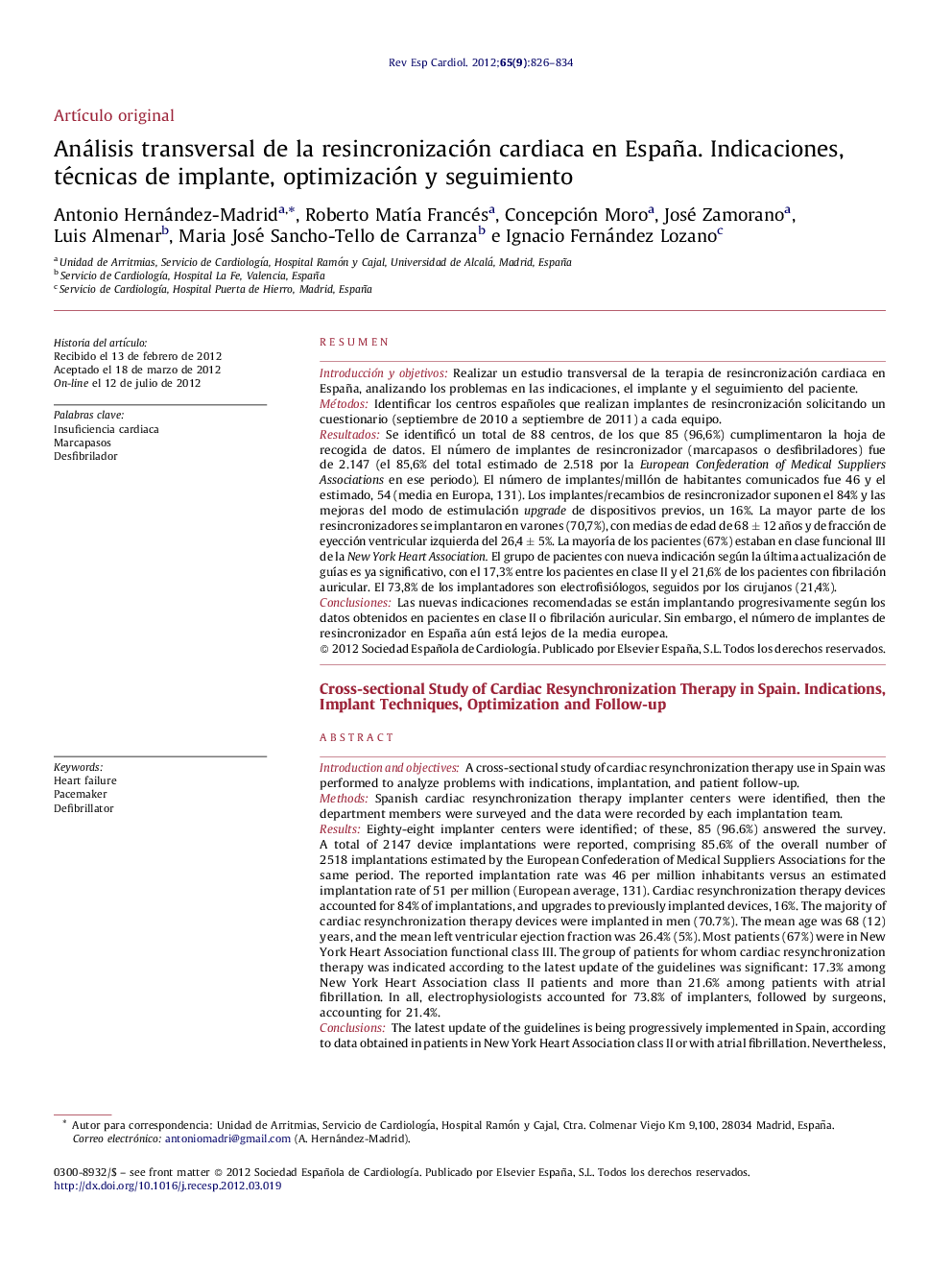| کد مقاله | کد نشریه | سال انتشار | مقاله انگلیسی | نسخه تمام متن |
|---|---|---|---|---|
| 3014833 | 1181912 | 2012 | 9 صفحه PDF | دانلود رایگان |

ResumenIntroducción y objetivosRealizar un estudio transversal de la terapia de resincronización cardiaca en España, analizando los problemas en las indicaciones, el implante y el seguimiento del paciente.MétodosIdentificar los centros españoles que realizan implantes de resincronización solicitando un cuestionario (septiembre de 2010 a septiembre de 2011) a cada equipo.ResultadosSe identificó un total de 88 centros, de los que 85 (96,6%) cumplimentaron la hoja de recogida de datos. El número de implantes de resincronizador (marcapasos o desfibriladores) fue de 2.147 (el 85,6% del total estimado de 2.518 por la European Confederation of Medical Suppliers Associations en ese periodo). El número de implantes/millón de habitantes comunicados fue 46 y el estimado, 54 (media en Europa, 131). Los implantes/recambios de resincronizador suponen el 84% y las mejoras del modo de estimulación upgrade de dispositivos previos, un 16%. La mayor parte de los resincronizadores se implantaron en varones (70,7%), con medias de edad de 68 ± 12 años y de fracción de eyección ventricular izquierda del 26,4 ± 5%. La mayoría de los pacientes (67%) estaban en clase funcional III de la New York Heart Association. El grupo de pacientes con nueva indicación según la última actualización de guías es ya significativo, con el 17,3% entre los pacientes en clase II y el 21,6% de los pacientes con fibrilación auricular. El 73,8% de los implantadores son electrofisiólogos, seguidos por los cirujanos (21,4%).ConclusionesLas nuevas indicaciones recomendadas se están implantando progresivamente según los datos obtenidos en pacientes en clase II o fibrilación auricular. Sin embargo, el número de implantes de resincronizador en España aún está lejos de la media europea.
Introduction and objectivesA cross-sectional study of cardiac resynchronization therapy use in Spain was performed to analyze problems with indications, implantation, and patient follow-up.MethodsSpanish cardiac resynchronization therapy implanter centers were identified, then the department members were surveyed and the data were recorded by each implantation team.ResultsEighty-eight implanter centers were identified; of these, 85 (96.6%) answered the survey. A total of 2147 device implantations were reported, comprising 85.6% of the overall number of 2518 implantations estimated by the European Confederation of Medical Suppliers Associations for the same period. The reported implantation rate was 46 per million inhabitants versus an estimated implantation rate of 51 per million (European average, 131). Cardiac resynchronization therapy devices accounted for 84% of implantations, and upgrades to previously implanted devices, 16%. The majority of cardiac resynchronization therapy devices were implanted in men (70.7%). The mean age was 68 (12) years, and the mean left ventricular ejection fraction was 26.4% (5%). Most patients (67%) were in New York Heart Association functional class III. The group of patients for whom cardiac resynchronization therapy was indicated according to the latest update of the guidelines was significant: 17.3% among New York Heart Association class II patients and more than 21.6% among patients with atrial fibrillation. In all, electrophysiologists accounted for 73.8% of implanters, followed by surgeons, accounting for 21.4%.ConclusionsThe latest update of the guidelines is being progressively implemented in Spain, according to data obtained in patients in New York Heart Association class II or with atrial fibrillation. Nevertheless, the number of cardiac resynchronization therapy device implants is still well below the European average.Full English text available from:www.revespcardiol.org
Journal: Revista Española de Cardiología - Volume 65, Issue 9, September 2012, Pages 826–834